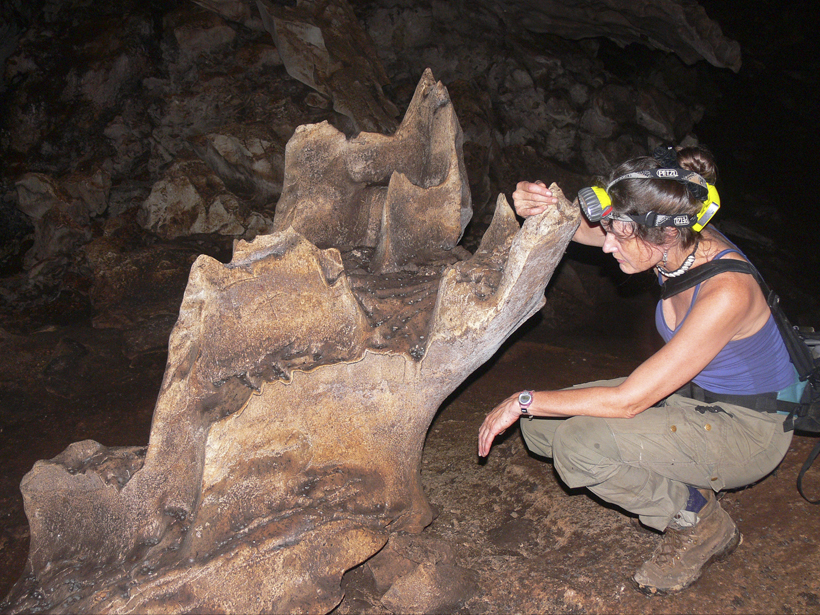Sixty meters below the ceiling of Gomantong cave, where hundreds of thousands of bats and birds roost, sits a towering mound of bat and bird guano. It can rise 10 to 12 meters high and crawls with thousands upon thousands of cockroaches and microorganisms. As these organisms decompose the guano, the droppings become acidic, full of nitric and phosphoric acid. This acid mixture slowly eats away at the cave walls, creating undercut features much like the way ocean waves erode limestone cliffs.
Although it may seem counterintuitive that a tiny animal’s bodily excretions could alter the geomorphology of a rock-walled cave, scientists are coming up with growing evidence that in some tropical caves, given enough time, that’s exactly what happens—and in a big way. Although researchers have devised ways to estimate the speed of the transformation in recent years, they have now embarked on experiments to directly measure the rate at which living creatures reshape the caves they inhabit.

As much as 70%–95% of the total volume of Gomantong cave—located in the Malaysian part of Borneo and well known to tourists and collectors of nests for making bird’s nest soup—may be attributed to biological activity and resulting collapses, Donald McFarlane, a cave ecologist at Claremont McKenna College in Claremont, Calif., told Eos.
Erosion by Excretion
The erosive acids stew in the shallow layers of the guano, just a few centimeters down, McFarlane explained. Farther down, the guano is very old—at a meter and a half below the moist surface, guano can be 40,000 years old. At this age, the guano is much more neutral, and erosion doesn’t happen.
Sometimes, boulders the size of chairs or cars fall from the cave’s ceiling into the guano, which erodes them into “quite spectacular shapes,” McFarlane said.
In addition to scouring solid rock, the excretions and the creatures they attract can test the tolerance of tropical cave researchers, who endure bat guano raining from the ceiling, cockroaches crawling into their boots and bags, and toxic levels of ammonia from bat urine, among other horrors.
This recent video from National Geographic gives a look as McFarlane and his colleagues encounter the teeming life and abundant by-products the creatures produce in Gomantong cave.

Bat and Bird Breath
Guano isn’t the only biological emission shaping the cave. When hundreds of thousands of bats and birds roosting in a cave exhale hot, moist air 18 hours a day, the cave walls experience additional erosion, McFarlane said.
The animals exhale warm, carbon dioxide (CO2)–rich air, which rises and encounters cooler cave walls, creating condensation. The chemical reaction between water and CO2 forms carbonic acid, which erodes the limestone. This reaction is similar to the way caves form when acidic water percolates through the soil above.
Besides creating large, cathedral-like pockets within the cave’s roof, bats and birds also carve out structures called apse flutes, which are long, vertical tube shapes that form regardless of the cave’s geology. When there is no significant source of water to found, the only explanation for these formations is biological, said Joyce Lundberg, a cave geomorphologist at Carleton University in Ottawa, Canada, in a video from Gomantong cave:

“I think people have known how important biological activity is in many other realms, but it hasn’t really ever been applied to speleology,” Lundberg told Eos.
Biological Impact
In a study published in 2011, Lundberg and McFarlane used mathematical models to deduce that over a large area of the Gomantong cave roof, bats and birds could erode a meter of rock every 300,000 years. Further, “In areas where you have very high density of bats, the modeling would suggest something close to 1 meter of rock in 30,000 years, so pretty substantial,” McFarlane said.
These rates are similar to what the researchers found this year in an African cave, Lundberg added.
Over the last three or four glacial cycles, “You can envisage a 50% increase in the size of the cave,” Lundberg said. She and McFarlane suspect that similar processes are shaping tropical caves all over the world.
Tile Tests
However, there’s a difference between models and nature, McFarlane said, which is why, 2 years ago, he and Lundberg placed small limestone tiles—called erosional plates—on the cave’s walls. When they collect the tiles in April 2016, McFarlane and Lundberg will examine them under an electron microscope. “That will give us a direct measure of how much erosion has occurred over 2 years,” McFarlane said.
In other upcoming measurements, McFarlane plans to further quantify the effects of bat guano by taking detailed pH measurements and microorganism profiles of guano deposits.
—JoAnna Wendel, Staff Writer
Citation: Wendel, J. (2015), How bat breath and guano can change the shapes of caves, Eos, 96, doi:10.1029/2015EO039053. Published on 9 November 2015.
Text © 2015. The authors. CC BY-NC 3.0
Except where otherwise noted, images are subject to copyright. Any reuse without express permission from the copyright owner is prohibited.

